四点提升GMAT阅读成绩
阅读理解提升方法

阅读理解提升方法有:
1.增加词汇量:扩大词汇量,多读各类文章,遇到生词勤查字典。
2.理解文章结构:学习并理解不同文体的文章结构,有助于把握
文章大意。
3.练习阅读:多读英文原著、新闻报道、学术论文等,逐步提高
阅读速度和理解能力。
4.批判性思考:在阅读时,尝试理解作者的观点,同时结合自己
的观点进行批判性思考。
5.学习阅读技巧:例如预测文章内容、寻找关键词和主题句、确
定作者意图等。
6.建立良好的阅读习惯:定时阅读、保持专注、遇到难点不妨放
慢速度、做好笔记等。
7.多维度学习:结合听、说、写、译等多方面的语言活动,全面
提升语言能力。
8.学习文化背景知识:了解英语国家的文化背景和习俗,有助于
更好地理解文章内容。
9.参加阅读课程或训练班:寻求专业的指导和帮助,可以更快地
提升阅读理解能力。
10.持续练习:任何技能都需要不断地练习才能保持和提高,阅读
理解也不例外。
总之,提高阅读理解能力需要长期坚持和多方面的努力。
希望这些建议能够帮助您提升阅读理解能力。
10个提高阅读理解能力的方法
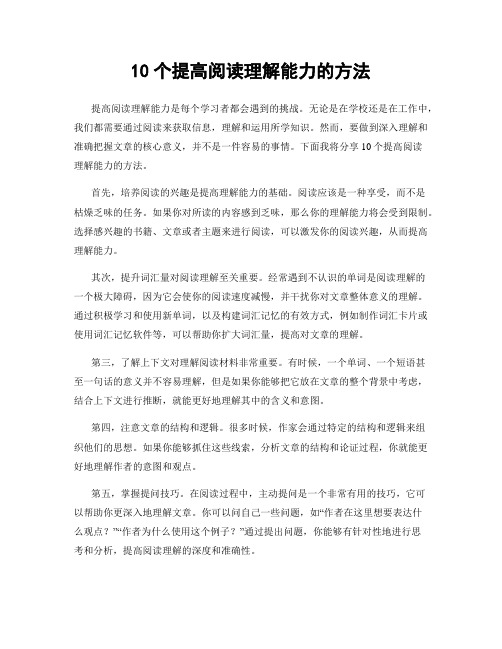
10个提高阅读理解能力的方法提高阅读理解能力是每个学习者都会遇到的挑战。
无论是在学校还是在工作中,我们都需要通过阅读来获取信息,理解和运用所学知识。
然而,要做到深入理解和准确把握文章的核心意义,并不是一件容易的事情。
下面我将分享10个提高阅读理解能力的方法。
首先,培养阅读的兴趣是提高理解能力的基础。
阅读应该是一种享受,而不是枯燥乏味的任务。
如果你对所读的内容感到乏味,那么你的理解能力将会受到限制。
选择感兴趣的书籍、文章或者主题来进行阅读,可以激发你的阅读兴趣,从而提高理解能力。
其次,提升词汇量对阅读理解至关重要。
经常遇到不认识的单词是阅读理解的一个极大障碍,因为它会使你的阅读速度减慢,并干扰你对文章整体意义的理解。
通过积极学习和使用新单词,以及构建词汇记忆的有效方式,例如制作词汇卡片或使用词汇记忆软件等,可以帮助你扩大词汇量,提高对文章的理解。
第三,了解上下文对理解阅读材料非常重要。
有时候,一个单词、一个短语甚至一句话的意义并不容易理解,但是如果你能够把它放在文章的整个背景中考虑,结合上下文进行推断,就能更好地理解其中的含义和意图。
第四,注意文章的结构和逻辑。
很多时候,作家会通过特定的结构和逻辑来组织他们的思想。
如果你能够抓住这些线索,分析文章的结构和论证过程,你就能更好地理解作者的意图和观点。
第五,掌握提问技巧。
在阅读过程中,主动提问是一个非常有用的技巧,它可以帮助你更深入地理解文章。
你可以问自己一些问题,如“作者在这里想要表达什么观点?”“作者为什么使用这个例子?”通过提出问题,你能够有针对性地进行思考和分析,提高阅读理解的深度和准确性。
第六,多角度思考是培养阅读理解能力的有效途径。
当你阅读一篇文章时,尝试从不同的角度来分析,挑战文章的观点和论证,并尝试找出不同的观点和解释。
这样的思考过程可以帮助你培养批判性思维,提高理解的灵活性和深度。
第七,阅读相关背景知识是提高理解能力的关键。
如果你对文章所涉及的主题有一定的了解,你就能更好地理解作者的意图和观点。
gmat考试有几篇阅读

gmat考试有几篇阅读要想考出理想的GMAT阅读成绩,考生一定要对GMAT阅读的基础有所了解。
那么下面和我来看看这篇gmat考试有几篇阅读的文章,一定会有收获的。
一、GMAT阅读的数量GMAT考试共有4篇阅读文章,穿插在语法和逻辑之间,篇幅和难度不等,共16题,主要考查主旨、细节信息、推理和结构。
GMAT语文部分由阅读、语法和逻辑三个部分组成,共41道题,GMAT考试时间为75分钟。
所以,阅读部分的答题时间还是比较紧迫的,考生一定要把握好做题时间。
从字数上看,GMAT阅读主要分为长阅读和短阅读。
长阅读通常有300-350字,短阅读通常有200-250字。
但无论是长阅读还是短阅读,其题目类型都是固定的。
一般 GMAT阅读的题目分为七类:主旨大意题、细节信息题、推理推断题、类比应用题、逻辑结构题、评价题和风格语调题。
了解并熟悉这七类题型,在选择答案时就可以做到心里有数。
二、GMAT阅读教学考查要点1.处理陌生信息的能力GMAT阅读部分主要考查考生在紧张环境下处理陌生文章、获取相关信息的能力,并不关怀考生是否能接受和记住这些信息。
所以GMAT阅读常常会有意使用一些非常广泛的主题,这样,任何人都会不可避免地碰到大量非本专业的文章。
在这个时候,你的信息处理能力将会成为GMAT阅读成绩凹凸的关键。
2.文字理解能力虽然GMAT并不像〔托福〕考试那样以词义为中心来展开题目,但很多题目都是以文章中描述的细节为基础的。
有些会要求考生选择对文章内容的同义复述,有些会要求考生选择简明扼要的语句来准确概括文章的含义,有些甚至会要求考生找出对文字含义的合理延伸。
所以GMAT阅读的字面意思理解是整个阅读过程中最基本的能力。
3.把握中心和文章结构在GMAT考试中,每一篇文章都是一个有机整体。
在一篇文章中,每一句话和一段话都是围绕一个中心或观点展开的。
有时候考生可以很清楚地找到文章的中心,但更多的时候,就必须要考生依据整篇文章的文字和结构来推断。
托福.SAT.雅思.GRE.GMAT.LSAT】通用提高阅读速度
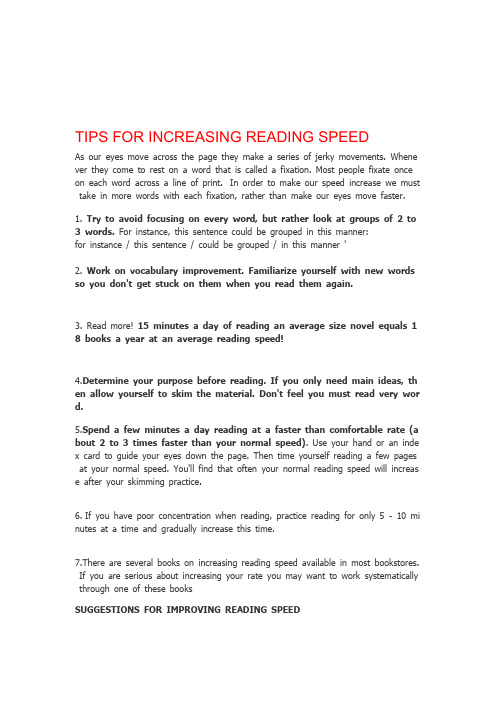
TIPS FOR INCREASING READING SPEEDAs our eyes move across the page they make a series of jerky movements. Whene ver they come to rest on a word that is called a fixation. Most people fixate once on each word across a line of print. In order to make our speed increase we must take in more words with each fixation, rather than make our eyes move faster. 1. Try to avoid focusing on every word, but rather look at groups of 2 to 3 words. For instance, this sentence could be grouped in this manner:for instance / this sentence / could be grouped / in this manner '2. Work on vocabulary improvement.Familiarize yourself with new words so you don't get stuck on them when you read them again.3. Read more! 15 minutes a day of reading an average size novel equals 1 8 books a year at an average reading speed!4.Determine your purpose before reading. If you only need main ideas, th en allow yourself to skim the material. Don't feel you must read very wor d.5.Spend a few minutes a day reading at a faster than comfortable rate (a bout 2 to 3 times faster than your normal speed). Use your hand or an inde x card to guide your eyes down the page. Then time yourself reading a few pages at your normal speed. You'll find that often your normal reading speed will increase after your skimming practice.6. If you have poor concentration when reading, practice reading for only 5 - 10 mi nutes at a time and gradually increase this time.7.There are several books on increasing reading speed available in most bookstores. If you are serious about increasing your rate you may want to work systematically through one of these booksSUGGESTIONS FOR IMPROVING READING SPEEDImprovement of Reading RateIt is safe to say that almost anyone can double his speed of reading while maintain ing equal or even higher comprehension. In other words,anyone can improve th e speed with which he gets what he wants from his reading.The average college student reads between 250 and 350 words per minute on fictio n and non-technical materials. A "good" reading speed is around 500 to 700 words per minute, but some people can read a thousand words per minute or even faster on these materials. What makes the difference? There are three main factors i nvolved in improving reading speed: (1) the desire to improve, (2) the wil lingness to try new techniques and (3) the motivation to practice. : Learning to read rapidly and well presupposes that you have the necessary vocabul ary and comprehension skills. When you have advanced on the reading comprehensi on materials to a level at which you can understand college-level materials, you will be ready to speed reading practice in earnest.The Role of Speed in the Reading ProcessUnderstanding the role of speed in the reading process is essential. Research has s hown a close relation between speed and understanding. For example, in checking progress charts of thousands of individuals taking reading training, it has been foun d in most cases that an increase in rate has been paralleled by an increase in com prehension, and that where rate has gone down, comprehension has also decrease d.Although there is at present little statistical evidence, it seems that plodding word-b y-word analysis (or word reading) inhibits understanding. There is some reason to b elieve that the factors producing slow reading are also involved in lowered compreh ension. Most adults are able to increase their rate of reading considerably and rathe r quickly without lowering comprehension. These same individuals seldom show an i ncrease in comprehension when they reduce their rate. In other cases,comprehen sion is actually better at higher rates of speed. Such results, of course, are h eavily dependent upon the method used to gain the increased rate. Simply reading more rapidly without actual improvement in basic reading habits usually results in lo wered comprehension.Factors that Reduce Reading RateSome of the facts which reduce reading rate: (a) limited perceptual span i.e., word-by-word reading; (b) slow perceptual reaction time, i.e., slowness of recognition and response to the material; (c) vocalization, including the need to vocalize in order t o achieve comprehension; (d) faulty eye movements, including inaccuracy in placement of the page, in return sweep, in rhythm and regularity of movement, etc.; (e) r egression, both habitual and as associated with habits of concentration; (f) faulty ha bits of attention and concentration, beginning with simple inattention during the rea ding act and faulty processes of retention; (g) lack of practice in reading, due simpl y to the fact that the person has read very little and has limited reading interests s o that very little reading is practiced in the daily or weekly schedule; (h) fear of los ing comprehension, causing the person to suppress his rate deliberately in the firm belief that comprehension is improved if he spends more time on the individual wor ds; (i) habitual slow reading, in which the person cannot read faster because he ha s always read slowly, (j) poor evaluation of which aspects are important and which are unimportant; and (k) the effort to remember everything rather than to rememb er selectively.Since these conditions act also to reduce comprehension increasing the reading rate through eliminating them is likely to result in increased comprehension as well. Thi s is an entirely different matter from simply speeding up the rate of reading withou t reference to the conditions responsible for the slow rate. In fact, simply speeding the rate especially through forced acceleration, may actually result, and often does, in making the real reading problem more severe. In addition, forced acceleration m ay even destroy confidence in ability to read. The obvious solution then is to increa se rate as a part of a total improvement of the whole reading process. This is a fu nction of special training programs in reading.Basic Conditions for Increased Reading RateA well planned program prepares for maximum increase in rate by establishing the necessary conditions. Four basic conditions include:1. Have your eyes checked. Before embarking on a speed reading program, make sure that any correctable eye defects you may have are taken care of by checking with your eye doctor. Often, very slow reading is related to uncorrected eye defe cts.2.Eliminate the habit of pronouncing words as you read.If you sound out words in your throat or whisper them, you can read slightly only as fast as you ca n read aloud. You should be able to read most materials at least two or three time s faster silently than orally. If you are aware of sounding or "hearing" words as yo u read, try to concentrate on key words and meaningful ideas as you force yourself to read faster.3. Avoid regressing (rereading). The average student reading at 250 words per minute regresses or rereads about 20 times per page. Rereading words and phrases is a habit which will slow your reading speed down to a snail's pace. Usually, it is unnecessary to reread words, for the ideas you want are explained and elaborated more fully in later contexts. Furthermore, the slowest reader usually regresses most frequently. Because he reads slowly, his mind has time to wander and his rereadi ng reflects both his inability to concentrate and his lack of confidence in his compre hension skills.4.Develop a wider eye-span.This will help you read more than one word at a glance. Since written material is less meaningful if read word by word, this will help you learn to read by phrases or thought units.Rate AdjustmentPoor results are inevitable if the reader attempts to use the same rate indiscriminat ely for a-1 types of material and for all reading purposes. He must learn to adjust his rate to his purpose in reading and to the difficulty of the material he is reading. This ranges from a maximum rate on easy, familiar, interesting material or in readi ng to gather information on a particular point, to minimal rate on material which is unfamiliar in content and language structure or which must be thoroughly digested. The effective reader adjusts his rate; the ineffective reader uses the same rate for all types of material.Rate adjustment may be overall adjustment to the article as a whole, or internal ad justment within the article. Overall adjustment establishes the basic rate at which th e total article is read; internal adjustment involves the necessary variations in rate f or each varied part of the material. As an analogy, you plan to take a 100-mile mo untain trip. Since this will be a relatively hard drive with hills, curves, and a mount ain pass, you decide to take three hours for the total trip, averaging about 35 mile s an hour. This is your overall rate adjustment. However, in actual driving you may slow down to no more than 15 miles per hour on some curves and hills, while sp eeding up to 50 miles per hour or more on relatively straight and level sections. Th is is your internal rate adjustment. There is no set rate, therefore, which the good reader follows inflexibly in reading a particular selection, even though he has set hi mself an overall rate for the total job.Overall rate adjustment should be based on your reading plan, your readi ng purpose, and the nature and difficulty of the material. The reading plan i tself should specify the general rate to be used. This is based on the total "size up ". It may be helpful to consider examples of how purpose can act to help d etermine the rate to be used. To understand information, skim or scan at a rap id rate. To determine value of material or to read for enjoyment, read rapidly or sl owly according to you feeling. To read analytically, read at a moderate pace t o permit interrelating ideas. The nature and difficulty of the material requ ires an adjustment in rate in conformity with your ability to handle that t ype of material. Obviously, level of difficulty is highly relative to the particular reader. While Einstein's theories may be extremely difficult to most laymen, they may be very simple and clear to a professor of physics. Hence, the layman and the phy sics professor must make a different rate adjustment in reading the same material. Generally, difficult material will entail a slower rate; simpler material will permit a faster rate.Internal rate adjustment involves selecting differing rates for parts of a given article. In general, decrease speed when you find the following (1) unfamiliar terminology not clear in context. Try to understand it in context at that point; otherwise, read o n and return to it later; (2) difficult sentence and paragraph structure; slow down e nough to enable you to untangle them and get accurate context for the passage;(3) unfamiliar or abstract concepts. Look for applications or examples of you own a s well as studying those of the writer. Take enough time to get them clearly in mi nd; (4) detailed, technical material. This includes complicated directions, statements of difficult principles, materials on which you have scant background; (5) material o n which you want detailed retention.In general, increase speed when you meet the following: (a) simple material with f ew ideas which are new to you; move rapidly over the familiar ones; spend most o f your time on the unfamiliar ideas; (b) unnecessary examples and illustrations. Sinc e these are included to clarify ideas, move over them rapidly when they are not ne eded; (c) detailed explanation and idea elaboration which you do not need, (d) bro ad, generalized ideas and ideas which are restatements of previous ones. These can be readily grasped, even with scan techniques.In keeping your reading attack flexible, adjust your rate sensitivity from article to ar ticle. It is equally important to adjust you rate within a given article. Practice these techniques until a flexible reading rate becomes second nature to you. SummaryIn summary, evidence has been cited which seems to indicate a need for and value of a rapid rate of reading, while at the same time indicating the dangers of speed in reading, as such. We have attempted to point out the relationship betw een rate of reading and extent of comprehension, as well as the necessity for adjustment of reading rate, along with whole reading attack, to the t ype of material and the purposes of the reader.Finally, the factors which reduce rate were surveyed as a basis for pointing out tha t increase in rate should come in conjunction with the elimination of these retarding aspects of the reading process and as a part of an overall reading training progra m where increase in rate is carefully prepared for in the training sequence.TIPS FOR IMPROVING YOUR READING SPEEDThe purpose of this section is to teach you how to increase you reading s peed. Shortly we will be adding a section for reading BETTER as opposed to FASTER.We all have a capacity for reading much faster than we typically do. Our reading s peed changes as we go through life. When we are in high school, we go through a bout two hundred words a minute. We get to college and, because we have to rea d faster due to more time constraints and a much greater amount to read, we rea d faster. Most people in college average about 400 words per minute. Then we get out of college, and now we don't have to read so fast. There are no longer time constraints, and we can read slow and easy. We find ourselves dropping back down to about 200 words per minute.Think of reading like you do a muscle, the more you read, the better you get at it, the faster you're going to read. And we have a great capacity for r eading faster. We aren't even scraping the surface of how fast we can read. You s ee, we have 1,000,000,000,000 brain cells. In fact, the inner connections, the synap ses, in our mind are virtually infinite. It has been estimated by a Russian scientist t hat the number of synapses we have would be one followed by 10 million kilomete rs of zeros. Our physical capacity for reading is beyond our comprehension. Our vis ual unit has the capability to take in a full page of text in 1/20 of a second. If we could turn the pages fast enough, our brain could process it faster than our eyes can see it. If we could turn those pages fast enough, our eyes have the capacity t o read a standard book in six to twenty-five seconds depending on the length of th e book. We could take in the entire Encyclopedia Britannica in one hour. So readin g 700 - 1,000 words a minute is easily within our reach.The key to improving our speed is to SIGHT READ, and that's what we are going t o show you how to do. We are going to start being pure sight readers. Obstacles get in our way, however. What do we mean by obstacles? Well, these are things t hat impede us from reading faster.REGRESSIONS are the most wasteful. Regressions are going back over words. You can call it back-skipping if you want. You go back over words you previously read. People do it for two reasons. Initially we read it to clarify the meaning of what we're reading. We want to be sure of the words we read as we go along. In our early years in school, when we were first taught - incorrectly - to " read slowly and carefully," it became easy to go back over words.Well, this not only slows you down, it causes you comprehension problem s.For instanc e, let’s say you have a sentence, "The man jumped over the log." We ll, if you back-skip, you read that passage like this: "The man jumped," "the man .. . jumped. . . over the log," "jumped over the log." So, what your brain is proce ssing, "The man jumped," "the man jumped," "jumped over the log." Our brain is u sed to processing our flaws, so the brain thinks, "OK, I know what this clown is sa ying, "The man jumped over the log." But this takes time to sort out. And it's conf using. Think how much easier it would be if you simply took the sentence in one si ght, "The man jumped over the log." There's no confusion there. Then you move o n to the next phrase. Regressing or back-skipping is the most harmful thing we do to slow our reading speed.Our second obstacle is that we have BAD HABITS that we pick up. Bad h abits manifest themselves in a number of ways. For one, you've got people who have MOTOR habits as they read. These are the people who are tapping a pe ncil when they read, tapping a foot when they read, moving a book, flicking their h and, etc. If they're sitting next to you, they drive you nuts. But they are the peopl e who have to be moving while they read.Some may even move their lips. If they do that, they're kind of edging over into a nother bad habit where we find AUDITORY readers. This is the bad habit that we have that is the hardest to drop. Auditory reading is difficult to beat because we ar e used to reading and hearing the words in our minds. Some people even go so fa r as to mumble the words. You can see their lips moving sometimes, or you can e ven hear a guttural growl as they go through the words.The other obstacle are the FIXATIONS. Fixations are the actual stops or pause s between eye-spans when the eye is moving to its next fixation point. We can't se e while the eye moves so you do need the fixation points to see. The problem is, most people fixate word by word by word. They stop their eyes on each separate word. The fixations slow you down because you are stopping on each word. )The problem that comes up here is this that, like the other obstacles, it impedes co ncentration and comprehension as well. The paradox with reading slowly is tha t it really hurts your concentration.Research has shown a close relation between speed and understanding. In checking progress charts of thousands of individuals taking reading training, its been found t hat in the vast majority of cases, that an increase in speed reading rate has also b een paralleled by an increase in comprehension. The plodding word by word analyz ation actually reduces comprehension.In this day and age, our brains are used to constant stimulation. Television, r adio, even people talking to you, provide constant stimulation. So when we are rea ding along slowly and carefully, it's kind of like watching a movie and we encounter a slow motion scene. The slow motion scene is kind of interesting at first because the movie has been moving along at a rapid clip and now we have a change of p ace. We've got the slow motion scene of the guy getting shot or the couple runnin g across to each other across a field, and the mind initially says, "Oh, this is cool. This is something different." After a while we get a little impatient and we're ready for the guy who got shot to hit the ground, or the couple who are running across the field to finally get to each other. We start thinking about other things..we’ve l ost our focus on the movie.The brain does the same thing when we read. The brain is getting all the stimulation it normally gets, then we hit this patch where you're reading slowly. And boom, the brain says, "I don't like this. I think I'm going to start thi nking about something else." And the reader starts thinking about the date they ha d Saturday night or the date they hope to have Saturday night. And therefore, you' ve got another impediment to comprehending the reading correctly.OK, what do we do? Well, there are several things we are going to do to increase reading speed. First of all. we are going to increase the EYE SPAN. Eye span is th e number of words that you take in as you look at the words. In other words, if my eye span is just one word, I am going to move from word to word to word. If my eye span is two words, I am going to move along twice as fast. If my eye sp an is three words, three times as fast. If I am moving along in phrases, I'm flying along pretty good.That's where you increase the rate of eye span. You also want to learn t o work in THOUGHT UNITS. Thought units help you move faster.This is w here you group the words accordi ng to context. For instance, let’s say you have, "H e said something." It's easy to put that in a phrase, then you move to the next ph rase. If I had this sentence, "It's safe to say that almost anyone can double his sp eed of reading while maintaining equal or higher comprehension." If I want to read that in phrases, "It's safe to say that almost anyone.......can double his speed........ of reading while maintaining.......equal or even higher comprehension." You move m uch faster that way.So, we are going to increase the number of words we see and we are go ing to group them according to context.One of the key things that we are al so going to work on is RETURN EYE SWEEP.When you get to the end of the se ntence or the end of the line on the written page, if your eye meanders back to the other side, you have a chance to pick up words. If you're picking up words and you're sight reading, that can be confusing. So you want to dramatically, quickly, fo rcefully, go from the end of one line to the beginning of the next one. Using a fin gertip or pen as a pointer is a great way to quickly and directly to the next line. The other thing that helps us increase our speed is CONFIGURATION. As you re ad faster and faster, you've got to learn to rely on your increased recogni tion of how words are configured, how they look, as you do it.In other w ords, "material" looks different than "response". "Recognition" looks different than "p erceptual". The words have visual configurations. As you learn to read faster an d faster you learn to pick up on the configurations and, as you do better and better, your skills at this improve with practice.So, we are going to have no REGRESSIONS, no VOCALIZATIONS, and incr eased EYE SPAN. T hat's the way to true sight reading. How do we do this? First, we avoid the problem areas. We avoid the limited eye-span by expanding the number of words that we take in. We get rid of regressions and we get rid of the return eye sweep problem by using a pointer. You can use a pen, a pencil, even your finger. That gives you a point of focus for your eyes. It helps you focus on th e page, and you move faster because you can dictate how fast you are moving acr oss the page. Your eye will follow your finger, or pen, or pencil.Absolutely stay away from the vocalizations.You have got to be a sight read er. You have got to read fast enough so that you don't have time to hear the wor ds. This way you are comprehending simply with your eyes.You also need to keep in mind that you don't always read at the same sp eed.If you've got a car that will go 120 miles per hour, you're not going to drive that care 120 miles per hour in a shopping center. You'd get killed and get a heck of a ticket. But you may, on a highway when you are passing a car, get it up to a high speed. When you are in that shopping center, you are going to be driving a bout 30 miles per hour.It's the same thing with reading. This is specifically addressed in our Better Re ading section. But you must learn that you speed read in certain areas and there a re other areas that may be particularly dense, that may have something that's parti cularly confusing to you, when you will need to slow down and read in shorter phr ases, smaller groupings of words so that you can comprehend it clearly. It may be a particularly dense passage where each word has great deal of meaning. It may b e even an unusual or specific word.Let's look at what we've got to do to practice it. The big step here is tosimply read faster.It sounds like such a simple statement, it almost sounds stupi d. But it's what you have to do. You have to focus on "I'm going to read faster," f irst.Comprehension comes later. Practice reading without a great concern for comprehension. In clinical terms, we call this the comprehension lag. It takes the mind as many as ten to fifteen days to adapt to the new reading rate.You are going to go through periods, practice periods, you can't use on school boo ks, but it's a practice period where you are simply adapting to reading that much f aster. Comprehension lags for a while but when it catches up it makes a stunning difference.A good place to practice this is magazines or newspapers.They have narr ow columns that almost make a perfect thought unit. You can almost go str aight down the column, taking that finger and puttting it in the middle of the colu mn and moving it straight down the page. You will be stunned how soon you will be able to improve and comprehend what you are reading that way. You find t hat it's quick. It's easy reading.。
GMAT考试数学高分技巧解析

GMAT考试数学高分技巧解析GMAT考试数学高分技巧解析GMAT考试中对数学的复习很多考生都觉得没什么难度,因此只是看看基础的数学词汇知识,做做GMAT数学题就上考场。
这样的复习对拿GMAT数学高分远远不够。
在下面列举几点GMAT考试数学高分技巧的解析。
第一点:(数学单词)或者大家可以针对单词,单词是基础中的基础,你的GMAT数学单词要掌握,才可以知道这个题目要求的是什么,当中用到了什么数据,或者过程当中你需要考虑到哪些点,所以这是理解能力。
还有一点就是你对题目的问题,这样才可以直观了解到这道题要求什么。
第二点:接下来就是GMAT考试数学的术语,那还是单词和词组的问题,就是说这是针对数学里的数学术语,要去背一背,当然这个很快,没有多少东西;因为大家之前都学过,因为GMAT数学并不涉及到高数,只是初中、高中的数学,之前都学过,对比之前学过的东西,能知道它是考什么就OK了;第三点:它没有问到的,你以为这是常识,把它给代进去了,这是你自己对这道题目的'假设,也就是说你不能把场外信息带入进去,这就是GMAT考试,你所有的信息,只有针对这个题目出现的考点和题目给出你的信息对它进行解答,你不能进行主观假设,你不能把场外的信息带进去,也许对,这是你在常识过程中、在日常生活中的常识,但是不能带进去,因为有很多数学题,你如果用常识来想,它是很荒谬的,但是最终它要求你得到答案,而不是检测你的常识。
第四点:下面一个是逻辑错误,逻辑错误就是说之前你不要跳步骤,一步一步来解答它,时间肯定够,你首先要有一个正确的解答过程,也就是说你理解了这个点之后,你对它进行一个顺向的思维,这就是逻辑的问题。
第五点:接下来就是技巧和反应的问题,数学最基本的三个点,知识的掌握配合一定量的练习,你要有一定量的练习,考试的时候才会有足够快的反应时间,才可以节省你的时间。
然后这些技巧也是在你的平时做题,OG、prep、GWD之类的其他复习的材料上来提高的,或者说让你掌握的,你题目见得多了,它不管出什么题,你可以很明显地知道它用什么方法,就很好解决了。
gmat如何考高分

gmat如何考高分gmat要怎么考高分呢?有什么方法技巧呢? 下面是我为大家整理的关于gmat如何考高分的相关资料,希望帮到大家。
一.阅读备考:1.GMAT阅读文章以哪些内容为主呢?包涵自然科学、人文社会和商业金融。
无论文章选材都趋向于专业性,但文章和题目并不会以专业内容为主导,考生即使不具备相关知识和专业背景,不会有理解和解题的障碍出现。
2.把词汇记忆和已知事物联系起来。
即学会运用联想来记忆单词。
要把这个未知的单词同已知的东西联系起来,可以加深对它的印象,从而快速记忆。
因此,尽可能多地让一个不会的单词与我们已知的东西发生联系,是有效记忆单词的重要方法。
二.数学备考:1.熟悉各种题型解题步骤,比如DS题,养成固定的解题习惯,先单独合计条件1,再看条件2,然后条件1+条件2。
DS题如果认为不充分的话,举出反例。
集合题画出韦恩图。
这种机械的步骤可以很大程度上克服粗心带来的失误。
2.认真总结自己错题的类型。
有可能是题意理解错误,计算粗心,没注意到DS题的条件1和条件2其实是等价的,某个知识点不熟悉,某类型的解题方法太复杂。
考试的时候你可能太熟悉或者题目太简单,一眼就看到答案了。
建议还是解答一遍,再验算一遍,保证不要有粗心或变体引起的不必要丢分。
如果真碰到卡壳的,也不要郁闷,即使错1到2个题还是可能51分的。
三.写作备考:1.在写作的时候,考生必须要明确就某一问题或观点的看法,这样会使你的文章重心特别。
注意在写作时,不要把你的论点当成一个问题,又抛给你的读者,而是要清楚的表达你的观点。
如果你无法就某一题目确定你的观点,请重新审阅题目,对其中的提示性语言做出一个outline。
不断的学习,将使你在这一方面取得长足的进步。
2.考生关于写作目的必须要有清楚地熟悉。
如果你对题目和目的没有熟悉,仅仅只是跟着自己想到的内容随便写,虽然有时候源自于潜意识的观点也是不错的,但与此相伴出现的问题是:你无法就给定的主题进行深入且慎重的讨论。
如何才能提高英语阅读理解能力?

如何才能提高英语阅读理解能力?作为一名教育专家,我偶尔会被当记者问到要如何提高英语阅读理解能力。
这是一个非常重要的问题,毕竟阅读理解能力是英语学习的基础,又是掌握其他语言技能(如写作练习、口语和听力)的关键。
提升英语阅读理解能力并非一蹴而就,需要一个系统的学习计划和长期坚持。
以下我将做出一些切实可行的建议:1. 扩充词汇量:词汇是阅读理解的基础,只有理解文章中的词汇,才能真正理解文章内容。
建议通过词汇书、词根词缀学习、阅读英文书籍和文章等来扩充词汇量。
2. 培养良好的阅读习惯:阅读是一个需要长期积累的过程,只有坚持阅读才能提高泛读能力。
建议每天抽出一定时间参与阅读,即使只有几分钟,也要坚持。
可以从简单的英文文章开始,逐渐提高难度。
3. 掌握阅读技巧:阅读技巧可以帮助我们更高效地理解文章内容。
常见的阅读技巧包括:略读、精读、扫读等。
根据不同的阅读目的,选择最合适的阅读技巧。
4. 注重批判性思维:阅读不仅仅是理解文章内容,更重要的是批判性思考。
要学会从不同的角度思考问题,并对文章进行分析和评价。
5. 利用多种资源学习:除了阅读书籍和文章,还可以利用其他资源学习,例如:在线课程:许多网站提供免费或付费的英语阅读理解课程,可以从中学习具体技巧。
英语学习软件:一些英语学习软件内置了阅读理解练习,可以帮助我们提高阅读能力。
英语学习社群:加入英语学习社群,可以与其他学习者交流学习经验,并互相帮助。
6. 结合实际应用:学习英语阅读理解不仅仅是为了考试,更重要的是为了实际应用。
可以尝试阅读英语新闻、杂志、书籍等,并进行思考和讨论。
7. 保持学习的积极性和兴趣:学习英语阅读理解是一个长期的过程,需要保持学习的积极性和兴趣。
可以选择自己喜欢的书籍和文章进行阅读理解,不断挑战自己。
总结:提高英语阅读理解能力需要扩充词汇量、培养阅读习惯、掌握阅读技巧、注重批判性思维、利用多种资源学习、结合实际应用、保持学习的积极性和兴趣。
提高英语阅读能力的5种基本方法

提高英语阅读能力的5种基本方法英语阅读要求我们在最短的时间内快速阅读,准确获取信息,这就需要我们多下点功夫,努力才会有收获。
以下是小编整理的关于提高英语阅读能力的5个方法,希望能帮到你。
1、多背单词。
词汇量的大小是进行阅读的基石,很难想象没有词汇量如何能完成阅读任务,更不要谈速度了。
如果我们积累了足够多的词汇量,看一篇文章的时候碰不到几个生词,可想而知,速度的提高是难以避免的,因为你在单位单词上停留的时间越少,对整个句子,乃至文段,就更能把握好。
2、注意力高度集中。
看一篇文章的时候,要撇开其他的私心杂念,做到心无旁骛,也就是说要把自己思想融入自己在看的文章之中。
提高自己的注意力不是说出来的,而是练出来的,一定要在平时自己做阅读练习的时候严格要求自己。
看一篇文章的时候要做到一口气看完,不要断断续续,更不要养成边看边默念的习惯。
3、用英语的方式思维。
看英语文章的时候,有些同学要把看到的东西先暗暗转译成中文才能理解,这说明他们的阅读能力还没有产生质的飞跃。
避免这种思维方式的途径只有一个,那就是提高自己的英语综和能力。
4、试着连句或是一目几行。
看一篇文章的时候,注意不要逐字逐字地看,或是一句句的看,要把两个或三个句子连起来,一气呵成,把它们看完,形成这种能力的关键,就是要加宽自己阅读时的视幅,这个能力的形成要下很大的苦功,送大家一句话吧:勤与不畏难是关键。
5、进行大量的阅读。
这是最后一点也是最重要的一点。
我的阅读速度的提高在根本上是个潜移默化的过程,也就是通过大量的阅读英语文章、书籍,使自己的阅读速度乃至阅读能力有了一个质的提高。
可以说我的阅读速度的提高过程是不知不觉的。
举个例子,我一度连续半年保持每天8-10篇英文散文或文论的阅读量,这样坚持下来,阅读的速度就上来了。
总之,提高阅读速度,没有捷径,要看大家的毅力有多强,勤奋度有多大。
半年之内通过自己持之以恒的努力是可以使自己的阅读速度有个质的提高的。
通过自己的努力获得的飞快的阅读速度,会使自己在英语阅读时得到巨大的享受,希望大家也能达到这一步,共同享受阅读的快乐。
如何提高英语阅读理解能力

如何提高英语阅读理解能力引导语:目前大部分学生的阅读理解能力仍较欠缺,其中很大部分原因就是缺乏良好的阅读习惯,未能掌握正确的阅读方法,不具备应有的的解题技巧。
下面有店铺给大家讲一下如何提高英语阅读理解能力吧,希望大家喜欢!如何提高英语阅读理解能力11、注意力要高度集中。
2、克服出声朗读、逐字阅读和回归倒读的习惯,而采用无声视读法。
3、运用概念阅读法组读。
4、运用垂直阅读法作纵向扫描。
5、采取跳读技巧,根据文献结构,抓住概要、掌握中心和重点。
6、提高英语阅读理解速度:(1)抓住每一段的首尾句如果作者够水准的话,他/她在每段的开头都会交代一下该段所的大概内容。
只要读每段的第一句话,你就能够判断出该段有没有你想了解的信息了。
如果你读的是文学作品的话,这个方法依然适用。
不过要知道,这样的话你可能会错过很多用于丰富故事的细节。
如果所读的文学作品妙语连珠的话,我会选择逐字逐句地拜读。
一段的最后一句话也应该会包含有关这段材料的重要性的线索。
段末一句话一般来说有2个功能-总结一下所表达的思想;为下一段作过渡。
(2)抓住关键词,忽略小品词。
当浏览过段首及段末的两句话后,如果你觉得这段内容值得你去读,你也不必逐字通读。
眼睛快速扫描每行文字,寻找词组和关键词。
你的大脑会自动帮你补全那些跳过的文字的。
忽略诸如it,to,a,an,and,be等“小词”-这些词你太熟悉了,(在阅读过程中,)你并不需要他们,你的大脑会自动识别这些小词的。
在以词组为单位进行阅读时,注意寻找要点。
(3)先略读 (skimming)。
所谓略读,是指以尽可能快的速读阅读,如同从飞机上鸟瞰 (bird''s eye view )地面上的明显标志一样,迅速获取文章大意或中心思想。
换句话说,略读是要求读者有选择地进行阅读,可跳过某些细节,以求抓住文章的大概,从而加快阅读速度。
(4)后寻读 (Scanning)寻读又称查读,同略读一样,寻读也是一种快速阅读技巧。
提高阅读理解能力的10个方法

提高阅读理解能力的10个方法阅读理解是一项十分重要的能力,不仅在学习中有着广泛的应用,也在日常生活中扮演着重要的角色。
然而,很多人在阅读过程中遇到困难,难以理解文章的主旨和细节。
本文将介绍10个提高阅读理解能力的方法,帮助你更好地理解和理解各种文章。
1. 遇到困难时止步思考在阅读过程中,难免会遇到一些生词、难句或不熟悉的内容。
这时,不要盲目地继续往下读,应该停下来思考。
可以回顾前文或者利用上下文的线索来推测词义,或者从句子结构和逻辑关系中分析句子的意思。
通过主动思考,可以更好地理解文章的内容。
2. 增加词汇量词汇是阅读理解的基础,提高词汇量可以更好地理解文章。
可以通过读书、听音乐、看电影等多种方式来扩大词汇量。
可以在阅读中遇到生词时及时查阅词典,了解和记忆生词的意思和用法。
此外,积累一些高频词汇和常用短语也是提高阅读理解的有效方法。
3. 阅读感兴趣的内容兴趣是最好的老师,在阅读中,选择自己感兴趣的内容可以更好地保持阅读的动力。
读自己喜欢的内容可以更轻松地理解文章,提高阅读理解能力。
同时,通过阅读感兴趣的内容,还能拓宽知识面,了解更多的领域知识。
4. 多读不同类型的文章阅读不同类型的文章有助于提高阅读理解能力。
可以读报纸、杂志、小说、科普书籍等多种不同类型的文章,熟悉不同类型的写作风格和结构。
通过多读不同类型的文章,可以锻炼自己的阅读能力,提高理解和应用不同类型文章的能力。
5. 牢固掌握阅读技巧阅读理解是一项需要技巧的任务,掌握一些常用的阅读技巧可以帮助你更好地理解文章。
比如,可以通过预览文章的标题、题目、段落标题等信息来预测文章的主旨;可以通过划线标记关键词和句子来帮助自己理清文章的逻辑结构;可以通过回顾文章的开头和结尾来确认阅读的理解是否正确等。
掌握这些阅读技巧可以有效提高阅读理解的能力。
6. 练习阅读速度和流畅度提高阅读理解能力的一个重要方面是提高阅读的速度和流畅度。
可以通过大量的阅读练习来提高阅读速度。
MBA英语考试技巧与经验分享

MBA英语考试技巧与经验分享MBA (Master of Business Administration)英语考试是申请MBA项目的重要组成部分,对考生的英语能力要求和应试技巧都有一定的挑战。
本文将分享一些MBA英语考试的技巧和经验,帮助考生更好地应对考试。
一、阅读理解阅读理解是MBA英语考试中的重要部分,主要考察考生的阅读理解能力和英语词汇量。
以下是一些用于提高阅读理解得分的技巧和经验。
1. 提前阅读英语学术材料:考生可在考前准备阶段多阅读英语学术材料,包括论文、期刊文章等,并通过摘要和关键词理解文章的主要内容,以增加自己的阅读理解能力。
2. 学习词汇量:扩大词汇量是提高阅读理解能力的关键。
考生可以通过背单词、使用词汇卡片等方式来积累和记忆生词,同时要注意词汇的用法和搭配。
3. 多做练习题:参加模拟考试和做真题是提高阅读理解能力的有效途径。
通过练习,考生可以熟悉考题的形式,提高解题速度和准确性。
二、写作技巧写作是MBA英语考试中的另一个重要内容,主要考察考生的英语表达能力和逻辑思维能力。
以下是一些建议和技巧,帮助考生提高写作得分。
1. 练习写作范围:通过多写不同主题的作文,考生可以提高写作的灵活性和适应性。
可以选择各类主题,包括经济、管理、社会等,提前准备可能出现的写作题目。
2. 组织文章结构:写作时要注意文章结构的合理性和逻辑性。
开头部分介绍主题,中间部分罗列事实和理由,结尾部分总结观点。
段落之间和句子之间要注意过渡的流畅性。
3. 使用适当的词汇和句式:考生可通过提前准备一些固定搭配、替换词汇和句式,用以增加文章的表达力。
同时要注意使用恰当的语气和措辞,避免语法和拼写错误。
三、口语表达口语表达是MBA英语考试中的一项重要内容,主要考察考生的口语流利程度和思维反应能力。
以下是一些提高口语表达能力的技巧和经验。
1. 多听多说:通过多听英语材料和多参与英语口语练习,考生可以提高自己的听力和口语表达能力。
GMAT阅读方法之自然阅读法

GMAT阅读方法之自然阅读法备考GMAT阅读考生除了要准备优质的备考资料还要掌握一些高效的备考方法,二者结合才能快速提升GMAT阅读能力。
接下来小编就为大家介绍GMAT阅读方法之自然阅读法,希望对大家的GMAT阅读备考有帮助。
什么是自然阅读法所谓自然阅读法,就是指通过认识单词,尤其是生词以及专业名词,来理解短语和句子,进而理解段落和整篇文章。
因此,掌握自然阅读法的基础就是保证自己的词汇量达到一定水平并且对GMAT阅读长难句有很好的掌握。
满足了以上两个条件才能轻松实现用自然阅读法备考GMAT阅读。
自然阅读法是考生非常熟悉的一种备考阅读的方法,它以单词背诵和句子理解为前提,在读懂句子的基础上掌握文章的主要内容。
但这并不意味着考生不用掌握文章结构,文章结构是文章的根基,决定着文章内容的走向和重点的分布。
并且,GMAT阅读对于文章中逻辑关系的考查也非常重视,因此,考生在掌握基本词汇和句子的基础上也要加强对文章结构的掌握。
自然阅读法的特点自然阅读的重点在于对词句的掌握,因此,考生首先要做的是保证自己的词汇量达到一定标准。
词汇量是阅读的基础,有了一定的词汇量积累,考生才能准确理解文章的意思,从而做出正确的选择。
从这一点讲,词汇是不能不背的。
背词汇和读文章是两种完全不同的能力,又是相互依赖的两种能力。
请大家一定要记住:最愚蠢的阅读方法就是一边查单词一边阅读。
这样做的结果是单词记不住,阅读速度也上不来。
GMAT阅读考试的一大特点,也是一大难点,就是充斥着一些很长或很怪异的句子,我们称之为GMAT难句。
从句、分词、不定式、插入语、介词短语等都可以看作GMAT阅读的复杂修饰成分,带有这些复杂修饰成分的句子读起来很拗口。
其中以阅读和逻辑单项题目中出现的难句对考生的杀伤力最大,GMAT阅读难句最难。
因此,GMAT阅读备考前期,考生要尽量用最短的时间攻克GMAT阅读难句。
如何用自然阅读法备考GMAT阅读既然自然化阅读法的特点就是对词汇和句子的掌握,考生在备考时就要着重对这两个方面进行强化,同时不要忽视对文章结构的掌握。
如何提高中考英语阅读理解

如何提高中考英语阅读理解提高中考英语阅读理解,可以这样做:1. 扩充词汇量词汇量是阅读理解的基础。
只有认识单词,才能理解文章的意思。
因此,要注重词汇量的积累,可以通过以下方法来扩充词汇量:认真学习课本中的单词,并进行复习和巩固。
利用词典或其他工具查询不认识的单词,并记录下来。
阅读英语文章、书籍等,在阅读中积累词汇。
2. 掌握阅读技巧阅读技巧可以帮助我们快速理解文章内容,提高阅读速度和准确率。
常见的阅读技巧包括:扫读文章,把握文章大意。
精读文章,理解细节和重点。
预测文章内容,提高阅读效率。
分析文章结构,理清文章脉络。
3. 培养良好的阅读习惯良好的阅读习惯可以帮助我们提高阅读兴趣,增强阅读理解能力。
建议养成以下阅读习惯:每天坚持阅读英语文章,做到日积月累。
在阅读中思考,积极与文本互动。
做好笔记,记录阅读心得。
4. 多做练习通过做练习,可以巩固所学的知识,提高阅读理解能力。
建议多做中考英语阅读理解练习题,并分析错题原因,不断改进。
学习方法如下:1.每天阅读英语文章每天坚持阅读英语文章,可以帮助我们熟悉英语语境,提高阅读速度和理解能力。
建议每天阅读一篇英语文章,文章题材可以是自己感兴趣的,也可以是与中考相关的。
2.精读文章精读文章,可以帮助我们深入理解文章内容,掌握细节和重点。
建议在精读文章时,先通读一遍,了解文章大意,然后仔细阅读每一句话,理解每个词语的意思和用法。
3.做笔记在阅读文章时,可以做一些笔记,记录下重要的信息和自己的理解。
这样可以帮助我们更好地记忆文章内容,提高阅读理解能力。
4.分析题目类型(1)细节事实题细节事实题包括多种类型,如直接细节事实、是非判断、例证和绝对类细节题。
解答这类题目的关键在于识别关键词,如数字、大写单词、人名或地名,并快速定位这些关键词在文章中的位置。
核对题目与文章内容,注意干扰选项,如观点混淆或回答肯定与否定的变化。
同时,仔细审读题目和包含答案的句子至关重要,以避免落入出题人设置的陷阱,如忽视句子其他成分,如定语和状语。
gmat小安阅读法
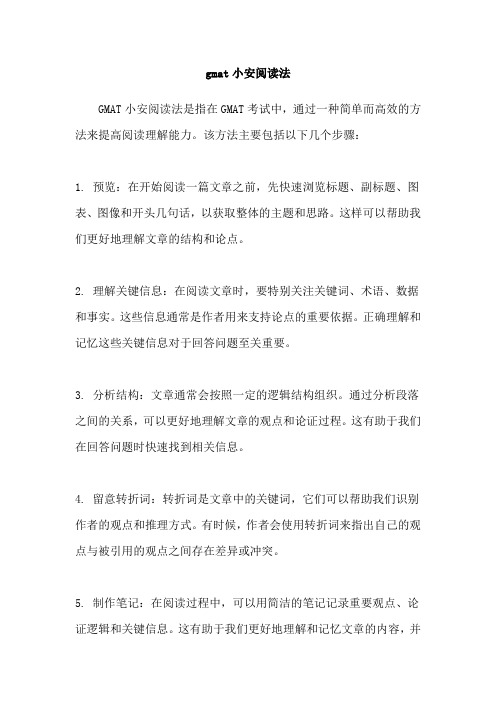
gmat小安阅读法
GMAT小安阅读法是指在GMAT考试中,通过一种简单而高效的方法来提高阅读理解能力。
该方法主要包括以下几个步骤:
1. 预览:在开始阅读一篇文章之前,先快速浏览标题、副标题、图表、图像和开头几句话,以获取整体的主题和思路。
这样可以帮助我们更好地理解文章的结构和论点。
2. 理解关键信息:在阅读文章时,要特别关注关键词、术语、数据和事实。
这些信息通常是作者用来支持论点的重要依据。
正确理解和记忆这些关键信息对于回答问题至关重要。
3. 分析结构:文章通常会按照一定的逻辑结构组织。
通过分析段落之间的关系,可以更好地理解文章的观点和论证过程。
这有助于我们在回答问题时快速找到相关信息。
4. 留意转折词:转折词是文章中的关键词,它们可以帮助我们识别作者的观点和推理方式。
有时候,作者会使用转折词来指出自己的观点与被引用的观点之间存在差异或冲突。
5. 制作笔记:在阅读过程中,可以用简洁的笔记记录重要观点、论证逻辑和关键信息。
这有助于我们更好地理解和记忆文章的内容,并
在回答问题时快速找到相关信息。
通过使用GMAT小安阅读法,我们可以有效地提高阅读理解能力,更好地理解和分析文章,从而在GMAT考试中取得更好的成绩。
同时,这种方法也可以培养我们的批判性思维和推理能力,对于日常生活和职业发展也是非常有益的。
快速提高英语阅读理解的方法
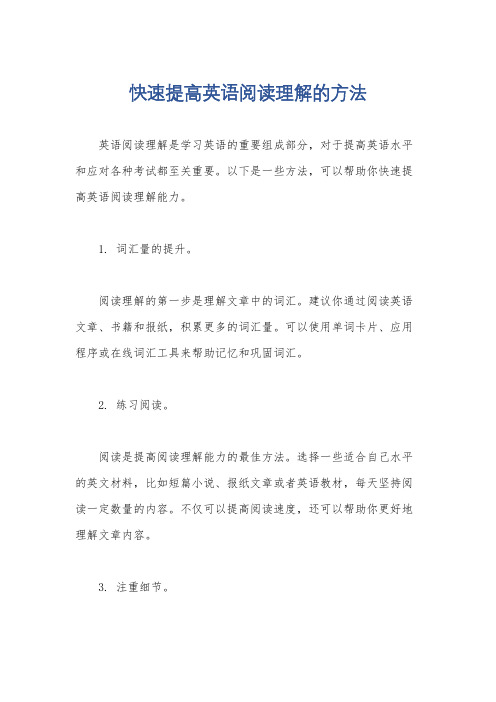
快速提高英语阅读理解的方法
英语阅读理解是学习英语的重要组成部分,对于提高英语水平和应对各种考试都至关重要。
以下是一些方法,可以帮助你快速提高英语阅读理解能力。
1. 词汇量的提升。
阅读理解的第一步是理解文章中的词汇。
建议你通过阅读英语文章、书籍和报纸,积累更多的词汇量。
可以使用单词卡片、应用程序或在线词汇工具来帮助记忆和巩固词汇。
2. 练习阅读。
阅读是提高阅读理解能力的最佳方法。
选择一些适合自己水平的英文材料,比如短篇小说、报纸文章或者英语教材,每天坚持阅读一定数量的内容。
不仅可以提高阅读速度,还可以帮助你更好地理解文章内容。
3. 注重细节。
在阅读过程中,要注重文章中的细节。
关注关键词、主题句和段落间的连接词,这些都是理解文章内容的重要线索。
同时,要注意文章中的例子、比喻和解释,这些可以帮助你更好地理解文章的含义。
4. 多维度阅读。
除了阅读英文文章外,还可以多维度地进行阅读。
比如,可以阅读与文章主题相关的其他材料,比如视频、音频或图片,这有助于更全面地理解文章内容。
5. 刻意练习。
最后,要进行刻意练习。
可以选择一些专门针对阅读理解的练习题,比如TOEFL、IELTS或SAT的阅读理解部分。
通过不断练习,可以提高自己的阅读理解能力。
总之,要提高英语阅读理解能力,关键在于坚持练习和多角度地进行阅读。
通过不断积累词汇、练习阅读和注重细节,相信你的英语阅读理解能力会有所提升。
【高分经验】GMAT备考全程各阶段全题型使用资料指点
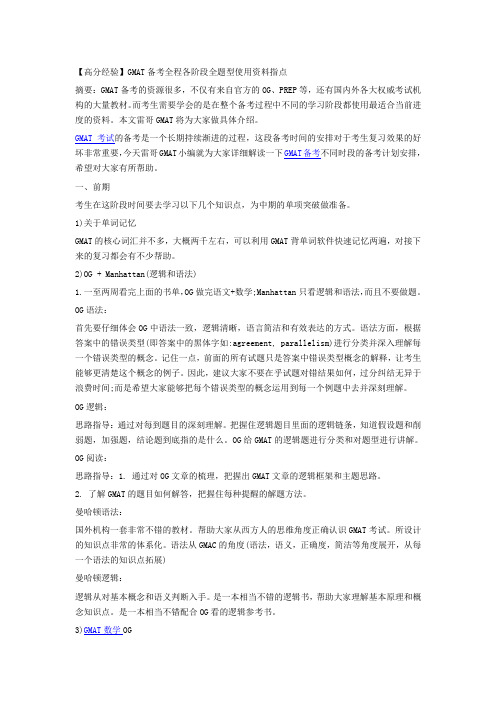
【高分经验】GMAT备考全程各阶段全题型使用资料指点摘要:GMAT备考的资源很多,不仅有来自官方的OG、PREP等,还有国内外各大权威考试机构的大量教材。
而考生需要学会的是在整个备考过程中不同的学习阶段都使用最适合当前进度的资料。
本文雷哥GMAT将为大家做具体介绍。
GMAT考试的备考是一个长期持续渐进的过程,这段备考时间的安排对于考生复习效果的好坏非常重要,今天雷哥GMAT小编就为大家详细解读一下GMAT备考不同时段的备考计划安排,希望对大家有所帮助。
一、前期考生在这阶段时间要去学习以下几个知识点,为中期的单项突破做准备。
1)关于单词记忆GMAT的核心词汇并不多,大概两千左右,可以利用GMAT背单词软件快速记忆两遍,对接下来的复习都会有不少帮助。
2)OG + Manhattan(逻辑和语法)1.一至两周看完上面的书单,OG做完语文+数学;Manhattan只看逻辑和语法,而且不要做题。
OG语法:首先要仔细体会OG中语法一致,逻辑清晰,语言简洁和有效表达的方式。
语法方面,根据答案中的错误类型(即答案中的黑体字如:agreement, parallelism)进行分类并深入理解每一个错误类型的概念。
记住一点,前面的所有试题只是答案中错误类型概念的解释,让考生能够更清楚这个概念的例子。
因此,建议大家不要在乎试题对错结果如何,过分纠结无异于浪费时间;而是希望大家能够把每个错误类型的概念运用到每一个例题中去并深刻理解。
OG逻辑:思路指导:通过对每到题目的深刻理解。
把握住逻辑题目里面的逻辑链条,知道假设题和削弱题,加强题,结论题到底指的是什么。
OG给GMAT的逻辑题进行分类和对题型进行讲解。
OG阅读:思路指导:1. 通过对OG文章的梳理,把握出GMAT文章的逻辑框架和主题思路。
2. 了解GMAT的题目如何解答,把握住每种提醒的解题方法。
曼哈顿语法:国外机构一套非常不错的教材。
帮助大家从西方人的思维角度正确认识GMAT考试。
如何提高阅读理解能力?(如何提高阅读理解能力英语作文)
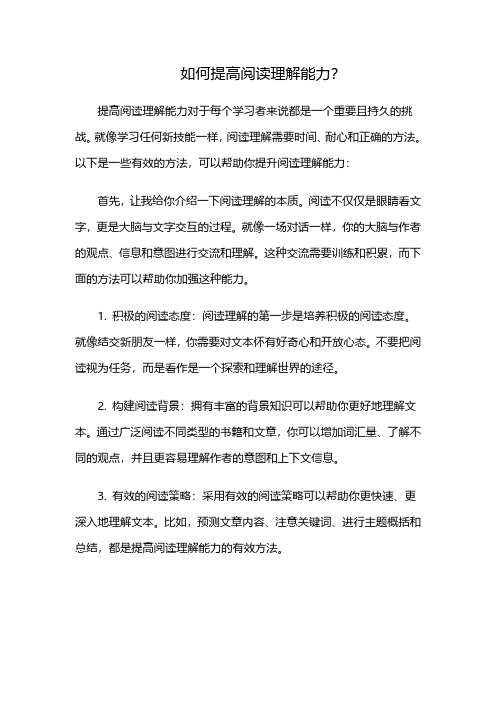
如何提高阅读理解能力?提高阅读理解能力对于每个学习者来说都是一个重要且持久的挑战。
就像学习任何新技能一样,阅读理解需要时间、耐心和正确的方法。
以下是一些有效的方法,可以帮助你提升阅读理解能力:首先,让我给你介绍一下阅读理解的本质。
阅读不仅仅是眼睛看文字,更是大脑与文字交互的过程。
就像一场对话一样,你的大脑与作者的观点、信息和意图进行交流和理解。
这种交流需要训练和积累,而下面的方法可以帮助你加强这种能力。
1. 积极的阅读态度:阅读理解的第一步是培养积极的阅读态度。
就像结交新朋友一样,你需要对文本怀有好奇心和开放心态。
不要把阅读视为任务,而是看作是一个探索和理解世界的途径。
2. 构建阅读背景:拥有丰富的背景知识可以帮助你更好地理解文本。
通过广泛阅读不同类型的书籍和文章,你可以增加词汇量、了解不同的观点,并且更容易理解作者的意图和上下文信息。
3. 有效的阅读策略:采用有效的阅读策略可以帮助你更快速、更深入地理解文本。
比如,预测文章内容、注意关键词、进行主题概括和总结,都是提高阅读理解能力的有效方法。
4. 多维度的理解:阅读不仅仅是理解表面文字意思,还包括理解作者的意图、情感色彩以及可能的隐含信息。
学会从多个角度去解读和分析文本,可以帮助你更全面地理解文章的内容和深层含义。
5. 反复练习:提高阅读理解能力需要持之以恒的练习。
通过阅读不同难度和风格的文章,并进行相关的练习题目,可以帮助你巩固所学的技能,并逐步提高自己的阅读理解水平。
最后,记住提高阅读理解能力是一个持久的过程,需要不断地学习、实践和调整。
通过以上的方法和建议,相信你可以逐步提升自己的阅读理解能力,更深入、更全面地理解各种类型的文本。
- 1、下载文档前请自行甄别文档内容的完整性,平台不提供额外的编辑、内容补充、找答案等附加服务。
- 2、"仅部分预览"的文档,不可在线预览部分如存在完整性等问题,可反馈申请退款(可完整预览的文档不适用该条件!)。
- 3、如文档侵犯您的权益,请联系客服反馈,我们会尽快为您处理(人工客服工作时间:9:00-18:30)。
备考GMAT阅读尤其是第一次参加GMAT考试的考生,首先要做的就是克服阅读恐惧,然后带着兴趣掌握考试要点,逐渐提升自己处理陌生信息的能力,逐步提升自己的阅读成绩。
本文就给大家介绍下四点提升GMAT阅读成绩的详细内容。
第一点:克服阅读恐惧
很多考生认为阅读篇幅大,读文章就需要花很多时间,再加上选择答案肯定是来不及,所以心里上莫名的增加了负担。
所以想要克服阅读恐惧,首先要把读句子的障碍克服。
句子读不明白无非是是单词或者长难句,你只有知道单词才可以理解一句话的意思,至于长难句很可能就是很关键的句子,这一部分推荐大家去看杨鹏的《长难句》,发现英语的表达方式有他们习惯的表达,读明白了,总结好了,就会很方便地读这个句子。
第二点:掌握阅读要点
GMAT考阅读考的很细很细,囫囵吞枣,慌着去看题的结果就是:看一道题回来读一遍文章,最后文章读了好几遍才弄明白,做阅读是一种享受,不是痛苦,如果你觉得痛苦就说明你文章没好好看就去做题了。
文章读得好,哪怕你花5分钟6分钟去读,回来做题可以达到30秒一道题,最后还是省时间的。
而且掌握关键词用法对于读懂GMAT 阅读文章脉络以及弄明白究竟问什么非常重要。
它们对读懂GMAT阅读理解文章脉络(强调这点)以及弄明白究竟在问的是什么非常重要。
第三点:提升阅读能力
事实上,ETS考的,就是你处理陌生信息的能力。
而这种能力的提高,取决于两个方面。
其一,真正扎实的语言功底。
毕竟,单词不认识,句法结构搞不清,其他的一切都是白搭。
所以建议通过大量背单词和大量泛读来提高语言能力。
其二就是解题的技巧,抓取文章中心思想的能力,除了基本的语言功底,还需要辅助巧妙地技巧才能提高正确率。
抓取中心思想还需要多加练习,熟悉中心句子的语感,个人感觉,以5篇阅读作为一个单位计时做的好处就是提高持久力,这样就不会感觉文章长就怵,并且对阅读速度有提高。
第四点:阅读做题渐入佳境
首先是熟悉题型,GMAT阅读常见题型有几种,分别是什么,每一种题型有什么突出特点、经过总结我们知道GMAT 阅读常见题型时固定的,主要包括推理判断题,类比应用题,主旨大意题,细节信息题,逻辑结构题,评价题和风格语调题七大常见题型。
每种题型都有其明显的标志词和特点,考生可以根据不同的题型特点进行有针对性的备考。
接着建立GMAT阅读框架,掌握做题技巧。
GMAT阅读中由于时间和篇幅的原因需要一定的做题技巧,能在短时间内提取有效信息,这就需要考生忽视一些细节重视文章框架。
整理出文章的论述结构、论证方法,考生会豁然开朗,发现GMAT阅读文章也不过如此。
以上就是关于四点提升GMAT阅读成绩的内容介绍,希望大家能够了解。
多多备考了解GMAT相关信息,争取做到万无一失。
更多关于GMAT阅读的内容介绍小编会为大家呈现。
最后祝大家顺利备考GMAT考试,早日梦圆名校。
